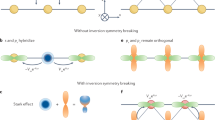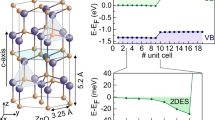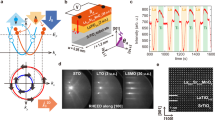Abstract
The spin–orbit interaction (SOI), mainly manifesting itself in heavy elements and compound materials, has been attracting much attention as a means of manipulating and/or converting a spin degree of freedom. Here, we show that a Si metal-oxide- semiconductor (MOS) heterostructure possesses Rashba-type SOI, although Si is a light element and has lattice inversion symmetry resulting in inherently negligible SOI in bulk form. When a strong gate electric field is applied to the Si MOS, we observe spin lifetime anisotropy of propagating spins in the Si through the formation of an emergent effective magnetic field due to the SOI. Furthermore, the Rashba parameter α in the system increases linearly up to 9.8 × 10−16 eV m for a gate electric field of 0.5 V nm−1; that is, it is gate tuneable and the spin splitting of 0.6 μeV is relatively large. Our finding establishes a family of spin–orbit systems.
This is a preview of subscription content, access via your institution
Access options
Access Nature and 54 other Nature Portfolio journals
Get Nature+, our best-value online-access subscription
$29.99 / 30 days
cancel any time
Subscribe to this journal
Receive 12 print issues and online access
$259.00 per year
only $21.58 per issue
Buy this article
- Purchase on Springer Link
- Instant access to full article PDF
Prices may be subject to local taxes which are calculated during checkout




Similar content being viewed by others
Data availability
Source data for the main paper figures are provided with this paper. Additional data are available from the corresponding authors on request.
Change history
28 July 2021
A Correction to this paper has been published: https://doi.org/10.1038/s41563-021-01086-0
References
Nitta, J., Akazaki, T., Takayanagi, H. & Enoki, T. Gate control of spin-orbit interaction in an inverted In0.53Ga0.47As/In0.52Al0.48As heterostructure. Phys. Rev. Lett. 78, 1335–1338 (1997).
Kato, Y. K., Myers, R. C., Gossard, A. C. & Awschalom, D. D. Coherent spin manipulation without magnetic fields in strained semiconductors. Nature 427, 50–53 (2003).
Murakami, S., Nagaosa, N. & Zhang, S.-C. Dissipationless quantum spin current at room temperature. Science 301, 1348–1351 (2003).
Kato, Y. K., Myers, R. C., Gossard, A. C. & Awschalom, D. D. Observation of the spin Hall effect in semiconductor. Science 306, 1910–1913 (2004).
Valenzuela, S. O. & Tinkham, M. Direct electronic measurement of the spin Hall effect. Nature 442, 176–179 (2006).
Saitoh, E., Ueda, M., Miyajima, H. & Tatara, G. Conversion of spin current into charge current at room temperature: inverse spin-Hall effect. Appl. Phys. Lett. 88, 182509 (2006).
Otani, Y., Shiraishi, M., Oiwa, A., Saitoh, E. & Murakami, S. Spin conversion on the nanoscale. Nat. Phys. 13, 829–832 (2017).
Ganichev, S. D. et al. Spin-galvanic effect. Nature 417, 153–156 (2002).
Rojas-Sanchez, J.-C. et al. Spin-to-charge conversion using Rashba coupling at the interface between non-magnetic materials. Nat. Commun. 4, 2944 (2013).
Ast, C. R. et al. Giant spin splitting through surface alloying. Phys. Rev. Lett. 98, 186807 (2007).
Ishizaka, K. et al. Giant Rashba-type spin splitting in bulk BiTeI. Nat. Mater. 10, 521 (2011).
de la Barrera, S. C. et al. Tuning Ising superconductivity with layer and spin-orbit coupling in two-dimensional transition-metal dichalcogenides. Nat. Commun. 9, 1427 (2018).
Ganguly, A. et al. Thickness dependence of spin torque ferromagnetic resonance in Co75Fe25/Pt bilayer films. Appl. Phys. Lett. 104, 072405 (2014).
Liu, L., Moriyama, T., Ralph, D. C. & Buhrman, R. A. Spin-torque ferromagnetic resonance induced by the spin Hall effect. Phys. Rev. Lett. 106, 036601 (2011).
Pai, C.-F. et al. Spin transfer torque devices utilizing the giant spin Hall effect of tungsten. Appl. Phys. Lett. 101, 122404 (2012).
Ghiasi, T. S., Ingla-Aynes, J., Kaverzin, A. A. & van Wees, B. Large proximity-induced spin lifetime anisotropy in transition-metal dichalcogenide/graphene heterostructures. Nano Lett. 17, 7528–7532 (2017).
Benitez, L. A. et al. Strongly anisotropic spin relaxation in graphene–transition metal dichalcogenide heterostructures at room temperature. Nat. Phys. 14, 303–308 (2018).
Safeer, C. K. et al. Room-temperature spin Hall effect in graphene/MoS2 van der Waals heterostructures. Nano Lett. 19, 1074–1082 (2019).
Benitez, L. A. et al. Tunable room-temperature spin galvanic and spin Hall effects in van der Waals heterostructures. Nat. Mater. 19, 170–175 (2020).
Xu, J., Zhu, T., Luo, Y. K., Lu, Y.-M. & Kawakami, R. K. Strong and tunable spin-lifetime anisotropy in dual-gated bilayer graphene. Phys. Rev. Lett. 121, 127703 (2018).
Leutenantsmeyer, J. C., Ingla-Aynes, J., Fabian, J. & van Wees, B. J. Observation of spin-valley-coupling-induced large spin-lifetime anisotropy in bilayer graphene. Phys. Rev. Lett. 121, 127702 (2018).
Ohtsubo, Y. et al. Spin-polarized semiconductor surface states localized in subsurface layers. Phys. Rev. B 82, 201307(R) (2010).
Guillet, T. et al. Observation of large unidirectional Rashba magnetoresistance in Ge(111). Phys. Rev. Lett. 124, 027201 (2020).
Ueno, K. et al. Electric-field-induced superconductivity in an insulator. Nat. Mater. 7, 855–858 (2008).
Chiba, D., Fukami, S., Shimamura, K., Ishiwata, N. & Ono, T. Electrical control of the ferromagnetic phase transition in cobalt at room temperature. Nat. Mater. 10, 853–856 (2011).
Dushenko, S. et al. Tunable inverse spin Hall effect in nanometer-thick platinum films by ionic gating. Nat. Commun. 9, 3188 (2018).
Raes, B. et al. Determination of the spin-lifetime anisotropy in graphene using oblique spin precession. Nat. Commun. 7, 11444 (2016).
Sasaki, T. et al. Temperature dependence of spin diffusion length in silicon by Hanle-type spin precession. Appl. Phys. Lett. 96, 122101 (2010).
O’Brien, L. et al. Observation of and modelling of ferromagnetic contact-induced spin relaxation in Hanle spin precession measurements. Phys. Rev. B 94, 094431 (2016).
Rojas-Sanchez, J.-C. et al. In-plane and out-of-plane spin precession in lateral spin-valves. Appl. Phys. Lett. 102, 132408 (2013).
Datta, S. & Das, B. Electronic analog of the electro-optic modulator. Appl. Phys. Lett. 56, 665–667 (1990).
Konakov, A. A. et al. Lande factor of the conduction electrons in silicon: temperature dependence. J. Phys. Conf. Ser. 324, 012027 (2011).
Acknowledgements
This research is supported in part by the Japan Society for the Promotion of Science (JSPS) Research Fellow Program (grant no. 18J22869), JST-PRESTO ‘Information Carrier’ Program and a Grant-in-Aid for Scientific Research (S) ‘Semiconductor Spincurrentronics’ (grant no. 16H06330).
Author information
Authors and Affiliations
Contributions
M.S. and S.L. conceived the experiments. H.K., M.G., S.M. and Y.S. fabricated samples. S.L. and N.Y. collected data. S.L., R.O., E.S., Y.A. and M.S. analysed the results. M.S. and S.L. wrote the paper. All authors discussed the results.
Corresponding author
Ethics declarations
Competing interests
The authors declare no competing interests.
Additional information
Peer review information Nature Materials thanks Juan-Carlos Rojas-Sánchez and the other, anonymous, reviewer(s) for their contribution to the peer review of this work.
Publisher’s note Springer Nature remains neutral with regard to jurisdictional claims in published maps and institutional affiliations.
Supplementary information
Supplementary Information
Supplementary Figs. 1–6, Refs. 1–5 and Discussion.
Source data
Source Data Fig. 1
Source data for Fig. 1
Source Data Fig. 2
Source data for Fig. 2
Source Data Fig. 3
Source data for Fig. 3
Source Data Fig. 4
Source data for Fig. 4
Rights and permissions
About this article
Cite this article
Lee, S., Koike, H., Goto, M. et al. Synthetic Rashba spin–orbit system using a silicon metal-oxide semiconductor. Nat. Mater. 20, 1228–1232 (2021). https://doi.org/10.1038/s41563-021-01026-y
Received:
Accepted:
Published:
Issue Date:
DOI: https://doi.org/10.1038/s41563-021-01026-y
This article is cited by
-
Highly anisotropic spin transport in ultrathin black phosphorus
Nature Materials (2024)
-
Geometric origin of intrinsic spin hall effect in an inhomogeneous electric field
Communications Physics (2022)
-
Silicon goes heavyweight
Nature Materials (2021)



